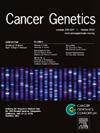68.ClinGen 癌症变异解释 (CVI):ClinGen/CGC/VICC致癌性标准操作程序的更新和建议
IF 1.4
4区 医学
Q4 GENETICS & HEREDITY
引用次数: 0
摘要
临床基因组资源(ClinGen)体癌变异解释委员会(ClinGen Somatic Cancer Variant Interpretation Committee,CVI)在专家小组程序中为 ClinGen 体癌变异鉴定专家小组(SC-VCEP)提供监督和建议。SC-VCEP 对致癌 SOP(PMID: 35101336)的使用为需要修改(SOP 更改)、建议(CVI 指导)或规范(SC-VCEP 基因/癌症特异性使用)的地方提供了重要的清晰度。我们总结了 SC-VCEP 肿瘤基因 SOP 的使用情况,为指南的制定提供参考。例如,组蛋白 H3 SC-VCEP 强调需要通过创建辅助证据代码 (OP5) 来纳入经典表型。CVI 要求在 OP2 中检测表型特异性,从而制定了 OP2 扩展使用建议。反之,如果 SC-VCEP 为癌症热点指定了阈值或替代数据库,则这些说明属于 SC-VCEP 的范围,不属于 CVI 的一般建议或对肿瘤致病性 SOP 的修改。我们正在研究两种常用的预测因子--REVEL 和 FATHMM,它们分别采用不同的随机森林集合预测算法和隐马尔可夫模型。在 "致癌 SOP "手稿中的一个小型变异集上,人工策划的 "真正 "致癌 GOF 和 LOF 变异在 REVEL 分数上显示出适度但显著的差异,而在 FATHMM 中则显示出更大的差异,具有潜在的鉴别应用价值。我们将报告这一比较的扩展情况以及一般使用方面的考虑。此外,我们还将分享在致癌 SOP 中纳入详细功能数据 (OS2) 的最新进展,并征求社区的反馈意见,同时考虑将结构化文本用于抗性变异的整理。本文章由计算机程序翻译,如有差异,请以英文原文为准。
68. ClinGen Cancer Variant Interpretation (CVI): Updates and recommendations on the ClinGen/CGC/VICC Oncogenicity SOP
The Clinical Genome Resource (ClinGen) Somatic Cancer Variant Interpretation Committee (CVI) provides oversight and recommendations in the expert panel process for ClinGen Somatic Cancer Variant Curation Expert Panels (SC-VCEPs). SC-VCEP use of the Oncogenicity SOP (PMID: 35101336) provides critical clarity where modifications (SOP changes), recommendations (CVI guidance), or specifications (SC-VCEP gene/cancer-specific use) are needed. We summarize SC-VCEP Oncogenicity SOP use informing guideline development. For example, Histone H3 SC-VCEP highlighted the need to incorporate classic phenotypes by creating a supporting evidence code (OP5). The CVI requested testing phenotype specificity within OP2, leading to developing recommendations on OP2 extended use. Conversely, if SC-VCEPs specify thresholds or alternative databases for cancer hotspots, these specifications are within the SC-VCEP scope and are not general CVI recommendations or modifications to the Oncogenicity SOP.
Additional work includes CVI developing guidance for using in-silico predictors (OP1). We are investigating two commonly used predictors - REVEL and FATHMM - that operate by distinct random forest ensemble prediction algorithms and the Hidden Markov model, respectively. On a small variant set from the Oncogenicity SOP manuscript, manually curated 'true' oncogenic GOF and LOF variants displayed modest but significant differences in REVEL scores and larger differences in FATHMM, with potential discriminatory applications. We will report on scaling this comparison as well as general-use considerations. In addition, we share updates and seek community feedback on incorporating detailed functional data (OS2) in the Oncogenicity SOP as well as considering structured text for the curation of resistance variants.
求助全文
通过发布文献求助,成功后即可免费获取论文全文。
去求助
来源期刊

Cancer Genetics
ONCOLOGY-GENETICS & HEREDITY
CiteScore
3.20
自引率
5.30%
发文量
167
审稿时长
27 days
期刊介绍:
The aim of Cancer Genetics is to publish high quality scientific papers on the cellular, genetic and molecular aspects of cancer, including cancer predisposition and clinical diagnostic applications. Specific areas of interest include descriptions of new chromosomal, molecular or epigenetic alterations in benign and malignant diseases; novel laboratory approaches for identification and characterization of chromosomal rearrangements or genomic alterations in cancer cells; correlation of genetic changes with pathology and clinical presentation; and the molecular genetics of cancer predisposition. To reach a basic science and clinical multidisciplinary audience, we welcome original full-length articles, reviews, meeting summaries, brief reports, and letters to the editor.
 求助内容:
求助内容: 应助结果提醒方式:
应助结果提醒方式:


